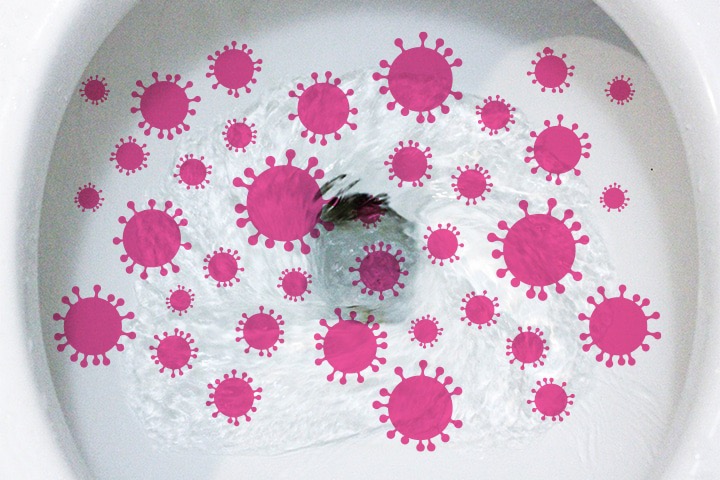Study: COVID-19 Is Also Spread by Fecal-Oral Route

Study: COVID-19 Is Also Spread by Fecal-Oral Route
by Diana Swift, Contributing Writer March 9, 2020
New research from China indicates that the novel coronavirus is also spread by fecal-oral transmission, not just by respiratory droplets or environmental contact.
Hong Shan, MD, PhD, of Fifth Affiliated Hospital, Sun Yat-sen University, in Zhuhai, Guangdong Province, and colleagues noted that the gastrointestinal tract is a welcoming environment for the virus, also known as severe acute respiratory syndrome (SARS) CoV-2. “Our immunofluorescent data showed that the ACE2 protein, which has been proved to be a cell receptor for SARS-CoV-2, is abundantly expressed in the glandular cells of gastric, duodenal, and rectal epithelia, supporting the entry of SARS-CoV-2 into the host cell,” the team wrote.
Among the key findings of the study, published online in Gastroenterology:
-
A significant portion of coronavirus patients experience diarrhea, nausea, vomiting, and/or abdominal discomfort before the onset of respiratory symptoms
-
Viral RNA is detectable in fecal samples from suspected cases, indicating that the virus sheds into the stool
-
Viral gastrointestinal infection and potential fecal-oral transmission can last even after viral clearance from the respiratory tract
The study looked at 73 patients hospitalized for possible COVID-19 and tested from February 1 to 14, 2020. Testing included serum, nasopharyngeal, and oropharyngeal swabs, as well as urine, stool, and tissue samples in accordance with China Disease Control and Prevention guidelines.
A total of 39 patients (53.4%; 25 males and 14 females), tested positive for fecal SARS-CoV-2 RNA. The age of patients with positive RNA in stool ranged from 10 months to 78 years, and the duration of stool positivity ranged from 1 to 12 days. Furthermore, the stool of 17 patients (23.3%) remained positive even after respiratory samples tested negative.
Intracellular staining of viral nucleocapsid protein in gastric, duodenal, and rectal epithelia showed that the virus infected glandular epithelial cells in these areas, the researchers reported. “The continuous positive detection of the viral RNA from feces suggests that the infectious virions are secreted from the virus-infected gastrointestinal cells.”
“Therefore, we strongly recommend that rRT-PCR [reverse transcriptase polymerase chain reaction] testing for SARS-CoV-2 from feces should be performed routinely in SARS-CoV-2 patients, and Transmission-Based Precautions for hospitalized SARS-CoV-2 patients should continue if feces tests positive by rRT-PCR testing,” Shan and co-authors advised.
Asked for his perspective, Douglas A. Corley, MD, PhD, of Kaiser Permanente San Francisco Medical Center and the University of California San Francisco, who was not involved with the research, told MedPage Today: “A better understanding of how this virus is transmitted is key to preventing its spread. These observations may also help in improving how the disease is diagnosed through testing for the presence of virus in the stool of patients suspected of harboring this virus.”
Also commenting, Peter Hotez, MD, of the National School of Tropical Medicine at Baylor College of Medicine in Houston, said the study adds to scientific discussions about whether gastrointestinal transmissions are relevant to the novel coronavirus infections, “especially in light of clinical descriptions of COVID-19 patients admitted to surgical wards in Wuhan who were thought to have abdominal emergencies.”
“It is a potentially important finding of relevance to the emergence of COVID-19 globally, but the exact extent of gastrointestinal transmission of the virus remains unclear,” Hotez told MedPage Today.
He added that whether fecal oral transmission is common or uncommon therefore requires additional investigation: “Also unclear is the significance of detection of viral RNA in the feces of patients with pulmonary disease, including those patients who were found to be PCR-negative in their respiratory secretions. The authors speculate that this might suggest that such patients may continue to transmit SARS-CoV-2, but this also requires further study,” said Hotez, who was not involved in the study.
In a second paper posted on the same day in the journal, Jinyang Gu, MD, of Xinhua Hospital of Jiao Tong University in Shanghai, and colleagues noted that evidence from the 2003 SARS epidemic also showed enteric involvement and the presence of virus in the stool of patients even after discharge from hospital. Interestingly, the team said, the first confirmed case of COVID-19 in the U.S., which occurred in Washington state, reported a 2-day history of nausea and vomiting on admission, followed by a loose bowel movement on the second day of hospitalization. The viral nucleic acids of loose stool and both respiratory specimens from this patient later tested positive.
Gu’s group also noted recent reports of mild to moderate liver injury in COVID-19 patients, including elevated aminotransferases, hypoproteinemia, and prothrombin time prolongation, while in the SARS epidemic of 2003, as many as 60% of patients had liver impairment.
“The presence of viral nucleic acids of SARS in liver tissue confirmed the coronavirus direct infection in liver, and percutaneous liver biopsies of SARS showed conspicuous mitoses and apoptosis along with atypical features such as acidophilic bodies, ballooning of hepatocytes, and lobular activities without fibrin deposition or fibrosis,” Gu and co-authors wrote. “Altogether, many efforts should be made to be alert [to] the initial digestive symptoms of COVID-19 for early detection, early diagnosis, early isolation, and early intervention.”
Disclosures
The study was funded by the National Natural Science Foundation of China.
Xiao and colleagues reported having no competing interests.
Gu and co-authors disclosed no competing interests.
Corley and Hotez reported having no competing interests in relation to their comments.
Primary Source
Gastroenterology
Source Reference: Xiao F, et al “Evidence for gastrointestinal infection of SARS-CoV-2” Gastroenterol 2020; DOI: 10.1053/j.gastro.2020.02.055.
Secondary Source
Gastroenterology
Source Reference: Gu J, et al “COVID-19: Gastrointestinal manifestations and potential fecal-oral transmission” Gastroenterol 2020; DOI: 10.1053/j.gastro.2020.02.054.
